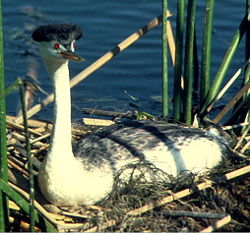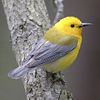Grebe
| Grebes | ||||||||||||
|---|---|---|---|---|---|---|---|---|---|---|---|---|
 Clark's Grebe, Aechmophorus clarkii
|
||||||||||||
| Scientific classification | ||||||||||||
|
||||||||||||
| Genera | ||||||||||||
|
Grebes are members of the Podicipediformes order, a widely distributed order of freshwater diving birds, some of which visit the sea when migrating and in winter. This order contains only a single family, the Podicipedidae, containing 22 species in 6 extant genera.
Contents |
Description

Grebes are small to medium-large in size, have lobed toes, and are excellent swimmers and divers. However, they have their feet placed far back on the body, can run for a short distance, but often fall over.
Grebes have narrow wings, and some species are reluctant to fly; indeed, two South American species are completely flightless[1]. They respond to danger by diving rather than flying, and are in any case much less wary than ducks. Extant species range in size from the Least Grebe, at 120 grams (4.3 oz) and 23.5 cm (9.3 inches), to the Great Grebe, at 1.7 kg (3.8 lbs) and 71 cm (28 inches).
However, the North American and Eurasian species are all, of necessity, migratory over much or all of their ranges, and those species that winter at sea are also seen regularly in flight. Even the small freshwater Pied-billed Grebe of North America has occurred as a transatlantic vagrant to Europe on more than 30 occasions.
Bills vary from short and thick to long and pointed, depending on the diet, which ranges from fish to freshwater insects and crustaceans. The feet are always large, with broad lobes on the toes and small webs connecting the front three toes. The hind toe also has a small lobe. Recent experimental work has shown that these lobes work like the hydrofoil blades of a propeller[1]. Curiously, the same mechanism apparently evolved independently in the extinct Cretaceous-age Hesperornithiformes, which are totally unrelated birds.
Grebes have unusual plumage. It is dense and waterproof, and on the underside the feathers are at right-angles to the skin, sticking straight out to begin with and curling at the tip. By pressing their feathers against the body, grebes can adjust their buoyancy. Often, they swim low in the water with just the head and neck exposed.
In the non-breeding season, grebes are plain-coloured in dark browns and whites. However, most have ornate and distinctive breeding plumages, often developing chestnut markings on the head area, and perform elaborate display rituals[1]. The young, particularly those of the Podiceps genus, are often striped and retain some of their juvenile plumage even after reaching full size.
When preening, grebes eat their own feathers, and feed them to their young. The function of this behaviour is uncertain but it is believed to assist with pellet formation and to reduce their vulnerability to gastric parasites.
Grebes make floating nests of plant material concealed among reeds on the surface of the water. The young are precocial, and able to swim from birth[1].
Taxonomy
The grebes are a radically distinct group of birds as regards their anatomy. Accordingly, they were at first believed to be related to the loons, which are also foot-propelled diving birds. However, as recently as the 1930s (Stolpe 1935), this was determined to be an example of convergent evolution by the strong selective forces encountered by unrelated birds sharing the same lifestyle at different times and in different habitat.
The cladistics vs. phenetics debate of the mid-20th century revived scientific interest in generalizing comparisons. As a consequence, the discredited grebe-loon link was discussed again. This even went as far as proposing monophyly for grebes, loons, and the toothed Hesperornithiformes (Cracraft, 1982). In retrospect, the scientific value of the debate lies more in providing examples that a cladistic methodology is not incompatible with an overall phenetical scientific doctrine, and that thus, simply because some study "uses cladistics", it does not guarantee superior results.
Molecular studies such as DNA-DNA hybridization (Sibley & Ahlquist, 1990) and sequence analyses fail to resolve the relationships of grebes properly due to insufficient resolution in the former and long-branch attraction in the latter. Still - actually because of this - they do confirm that these birds form a fairly ancient evolutionary lineage (or possibly one that was subject to selective pressures down to the molecular level even), and they support the non-relatedness of loons and grebes.
However, because of the recent improvements in sequencing technology, the question of the taxonomy of grebes has finally been resolved. A recent phylogenomic study of the deep evolutionary relationships in birds shows definitively that grebes are most closely related to flamingos. By collecting a large DNA sequence data bank, scientists were able to address the phylogenomic relationships from 171 species which represented all major passerine clades, all but three nonpasserine families, and two crocodile outgroups. All major extant groups were represented in this study, where they examined ~32 kilobases of aligned nuclear DNA sequences from 19 different loci for the 169 bird species plus the two crocodile outgroups (Hackett et al. 2008). This study validates earlier proposals of this relationship that have generally been ignored, even though careful analyses of morphological characters (i.e., excluding known homoplasies) and molecular data had suggested that this relationship was the most promising hypothesis to date. In addition, it was shown that the Anaticola bird lice shared by flamingos and waterfowl, which were at one time used to support a close relationship between the latter two (which is now deemed utterly incorrect), are actually closely related to the grebes' Aquanirmus lice and almost certainly switched hosts from flamingos to waterfowl, not the other way around as it was usually assumed (Johnson et al. 2006).
Genera and species
- Genus Tachybaptus
- Little Grebe, Tachybaptus ruficollis
- Australasian Grebe Tachybaptus novaehollandiae
- Madagascar Grebe, Tachybaptus pelzelnii
- Alaotra Grebe, Tachybaptus rufolavatus — probably extinct (late 1980s)
- Least Grebe, Tachybaptus dominicus
- Genus Podilymbus
- Pied-billed Grebe, Podilymbus podiceps
- Atitlán Grebe, Podilymbus gigas — extinct (1989)
- Genus Rollandia
- White-tufted Grebe, Rollandia rolland
- Titicaca Flightless Grebe, Rollandia microptera
- Genus Poliocephalus
- Hoary-headed Grebe, Poliocephalus poliocephalus
- New Zealand Dabchick, Poliocephalus rufopectus
- Genus Podiceps
- Red-necked Grebe, Podiceps grisegena
- Great Crested Grebe, Podiceps cristatus
- Slavonian Grebe or Horned Grebe, Podiceps auritus
- Black-necked Grebe or Eared Grebe, Podiceps nigricollis
- Colombian Grebe, Podiceps andinus — extinct (1977)
- Great Grebe, Podiceps major
- Silvery Grebe, Podiceps occipitalis
- Junin Flightless Grebe, Podiceps taczanowskii
- Hooded Grebe, Podiceps gallardoi
- Genus Aechmophorus
- Western Grebe, Aechmophorus occidentalis
- Clark's Grebe, Aechmophorus clarkii
Fossil grebes
The fossil record of grebes is incomplete; there are no transitional forms between more conventional birds and the highly derived grebes known from fossils, or at least none that can be placed in the relationships of the group with any certainty. The enigmatic waterbird genus Juncitarsus, however, may be close to a common ancestor of flamingos and grebes.
The Late Cretaceous (Berriasian, around 143 mya) genus Eurolimnornis from NW Romania was initially believed to be a grebe. If it is indeed related to this lineage, it must represent a most basal form, as it almost certainly predates any grebe-flamingo split. On the other hand, the single bone fragment assigned to this taxon is not very diagnositc and may not be of a bird at all (Benton et al., 1997).
Telmatornis from the Navesink Formation - also Late Cretaceous - is traditionally allied with the Charadriiformes and/or Gruiformes.. However, a cladistic analysis of the forelimb skeleton (Varricchio 2002) found it highly similar to the Great Crested Grebe and unlike the Painted Buttonquail (now known to be a basal charadriiform lineage), the Black-necked Stilt (a more advanced charadriiform), or the Limpkin (a member of the Grui suborder of Gruiformes), namely in that its dorsal condyle of the humerus was not angled at 20°–30° away from long axis of the humerus. The analysis did not result in a phylogenetic pattern but rather grouped some birds with similar wing shapes together while others stood separate. It is thus unknown whether this apparent similarity to grebes represents an evolutionary relationship, or whether Telmatornis simply had a wing similar to that of grebes and moved it like they do.
True grebes suddenly appear in the fossil record in the Late Oligocene or Early Miocene, around 23-25 mya. While there are a few prehistoric genera that are now completely extinct, Thiornis (Late Miocene -? Early Pliocene of Libros, Spain) and Pliolymbus (Late Pliocene of WC USA - Early? Pleistocene of Chapala, Mexico) date from a time when most if not all extant genera were already present. Only the Early Miocene Miobaptus from Czechoslovakia might be somewhat closer to the ancestral grebes, but more probably belongs to an extinct lineage. Indeed, Miobaptus is rivalled or even exceeded in age by a species of the modern genus Podiceps.
A few more recent grebe fossils could not be assigned to modern or prehistoric genera as of now:
- Podicipedidae gen. et sp. indet. (San Diego Late Pliocene of California) - formerly included in Podiceps parvus (Murray 1967)
- Podicipedidae gen. et sp. indet. UMMP 49592, 52261, 51848, 52276, KUVP 4484 (Late Pliocene of WC USA: Jehl 1967)
- Podicipedidae gen. et sp. indet. (Glenns Ferry Late Pliocene/Early Pleistocene of Idaho, USA: Wetmore 1933, Jehl 1967)
References
- Benton, M. J.; Cook, E.; Grigorescu, D.; Popa, E. & Tallódi, E. (1997): Dinosaurs and other tetrapods in an Early Cretaceous bauxite-filled fissure, northwestern Romania. Palaeogeography, Palaeoclimatology, Palaeoecology 130: 275-292. doi:10.1016/S0031-0182(96)00151-4 PDF fulltext
- Cracraft, Joel (1982): Phylogenetic relationships and monophyly of loons, grebes, and hesperornithiform birds, with comments on the early history of birds. Systematic Zoology 31: 35-56. doi:10.2307/2413412 (HTML abstract)
- Jehl, Joseph R. Jr. (1967): Pleistocene Birds from Fossil Lake, Oregon. Condor 69(1): 24-27 PDF fulltext
- Johnso, Kevin P.; Kennedy, Martyn & McCracken, Kevin G. (2006): Reinterpreting the origins of flamingo lice: cospeciation or host-switching? Biol. Lett. 2: 275–278. doi:10.1098/rsbl.2005.0427 PDF fulltext
- Hackett, S. J.; Kimball, R. T.; Reddy, S.; Bowie, R. C. K.; Braun, E. L.; Braun, M. J.; Chojnowski, J. L.; Cox, A.; Han, K.; Harshman, J.; Huddleston, C. J.; Marks, B. D.; Miglia, K. J.; Moore, W. S.; Sheldon, F. H.; Steadman, D. W.; Witt, C. C. & Tamaki, Y (2008):A Phylogenomic Study of Birds Reveals Their Evolutionary History. Science 320: 1763 - 1768. PDF fulltext
- Konter, André (2001): Grebes of our world: visiting all species on 5 continents. Lynx Edicions, Barcelona. ISBN 84-87334-33-4
- Murray, Bertram G. Jr. (1967): Grebes from the Late Pliocene of North America. Condor 69(3): 277-288. PDF fulltext
- Ogilvie, Malcolm & Rose, Chris (2003): Grebes of the World. Bruce Coleman Books, Uxbridge, England. ISBN 1-872842-03-8
- Sibley, Charles Gald & Monroe, Burt L. Jr. (1990): Distribution and taxonomy of the birds of the world: A Study in Molecular Evolution. Yale University Press, New Haven, CT. ISBN 0-300-04969-2
- Stolpe, M. (1935): Colymbus, Hesperornis, Podiceps:, ein Vergleich ihrer hinteren Extremität. J. Ornithol. 80(1): 161-247. [Article in German] doi:10.1007/BF01908745
- Varricchio, David J. (2002): A new bird from the Upper Cretaceous Two Medicine Formation of Montana. Canadian Journal of Earth Sciences 39(1): 19-26. HTML abstract
- Wetmore, Alexander (1933): Pliocene bird remains from Idaho. Smithsonian Miscellaneous Collections 87: 1-12.
External links
- Internet Bird Collection: Grebe videos
- Tree of Life Grebes
- openclipart.org: Grebes clip-art
- Diving Birds of North America, by Paul Johnsgard
|
||||||||||||||||||||||||||
